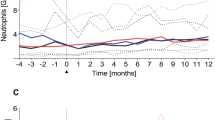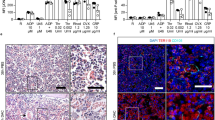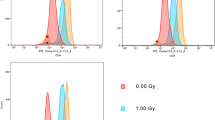Abstract
LEUCOCYTE depression is often produced by localized radiation therapy. This frequently appears inordinate for the amount of bone marrow within the radiated field. A possible explanation for this leucopsenia is that during a course of radiation therapy (usually given in daily doses for a number of weeks) a large number of circulating stem cells1−6 enter the radiated field, are destroyed, and thus a leucocyte depression is produced. I have attempted to test this hypothesis in previous experiments7,8 by subjecting two groups of mice to partial body irradiation. Both groups received the same total dose; however, one group was radiated for 2–3 min while the other was exposed for 100–120 min. If the hypothesis is correct, then the mice exposed for the longer duration should develop a more profound and prolonged leucopænia. This is what was observed. The present experiment attempts, more directly, to observe the effects of the duration of partial body irradiation on the number of circulating stem cells to see whether these changes in the leucocyte levels reflect changes in stem cells.
This is a preview of subscription content, access via your institution
Access options
Subscribe to this journal
Receive 51 print issues and online access
$199.00 per year
only $3.90 per issue
Buy this article
- Purchase on Springer Link
- Instant access to full article PDF
Prices may be subject to local taxes which are calculated during checkout
Similar content being viewed by others
References
Swift, M. N., Taketa, S. T., and Bond, V. P., Rad. Res., 1, 241 (1954).
Bond, V. P., Cronkite, E. P., Fliedner, T. M., and Schork, P., Science, 128, 202 (1958).
, Bond, V. P., Fliedner, T. M., Cronkite, E. P., and Andrews, G., J. Lab. and Clin. Med., 57, 711 (1961).
Petrakis, N. L., and Politis, G., New England J. Med., 267, 286 (1962).
Goodman, J. W., and Hodgson, G. S., Blood, 19, 702 (1962).
Trobaughh, jun., F. E., and Lewis, J. P., J. Clin. Invest., 43, 1306 (1964).
Hellman, S., Rad. Res., 22, 195 (1964).
Hellman, S., Rad. Res. (in the press).
Till, J. E., and McCulloch, E. A., Rad. Res., 14, 213 (1961).
Becker, A. J., McCulloch, E. A., and Till, J. E., Nature, 197, 452 (1963).
Till, J. E., McCulloch, E. A., and Siminovitch, L., Proc. U.S. Nat. Acad. Sci., 51, 29 (1964).
McCulloch, E. A., and Till, J. E., J. Cell Comp. Physiol., 61, 301 (1963).
Thomson, J. F., and Tourtellotte, W. W., Amer. J. Roentgenol. Rad. Therapy and Nuclear Med., 69, 826 (1953).
Neal, F. E., Intern. J. Rad. Biol., 2, 295 (1960).
Brown, J. A. H., Corp, M. J., and Westgarth, D. R., Intern. J. Rad. Biol, 2.371 (1960).
Fowler, J. F., and Lawrey, J. M., Brit. J. Rod., 33, 382 (1960).
Logie, L. C., Harris, M. D., Talsch, R. E., and Van Hauser, E. N., Rad. Res., 12, 349 (1960).
Hanks, G. E., USNRDL–TR–762 (July 7, 1964).
Author information
Authors and Affiliations
Rights and permissions
About this article
Cite this article
HELLMAN, S. Circulating Stem Cells : Variation with Duration of Partial Body X-irradiation. Nature 205, 100–101 (1965). https://doi.org/10.1038/205100a0
Published:
Issue Date:
DOI: https://doi.org/10.1038/205100a0
This article is cited by
-
Embryonic Mouse Peripheral Blood Colony-forming Units
Nature (1970)
Comments
By submitting a comment you agree to abide by our Terms and Community Guidelines. If you find something abusive or that does not comply with our terms or guidelines please flag it as inappropriate.



